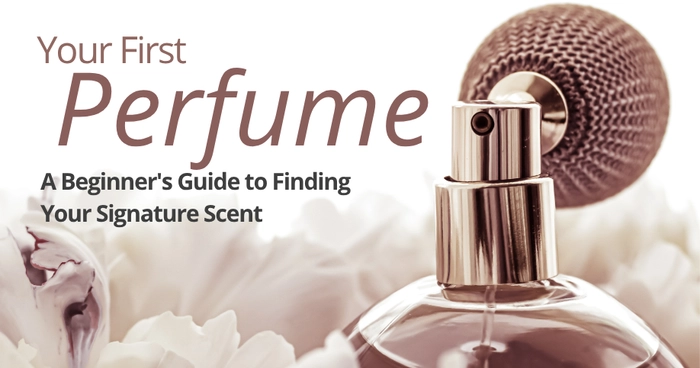The way you smell can tell a story. A single spritz of perfume can spark old memories, make you feel more sure of yourself, or simply show off who you are. Scent is a truly personal thing. It wraps around you like an invisible cloak, leaving a lasting impression. It’s more than just a nice smell; it's a part of your identity.
But stepping into the world of perfumes for the first time can feel overwhelming. Aisles full of bottles, a cloud of different scents—where do you even start? This guide helps you begin your exciting journey to find that special smell, your "signature scent." This is the one fragrance that feels like "you" and truly expresses your unique style.
This guide will walk you through the basics of fragrance. You'll learn how to tell perfumes apart and how to try them on. By the end, you'll feel ready to discover a scent that speaks directly to you.
Understanding Perfume Basics: What's in the Bottle?
The Anatomy of a Fragrance: Notes and Families
Perfumes are more complex than they seem. They're built in layers, much like a song has different parts. These layers are called "notes." There are three kinds of notes, each with its own role.
- Top Notes: These are the first scents you smell right after spraying. Think of them as the opening act. They're usually light and fresh, like citrus or herbs. But they fade away quickly, often within minutes.
- Middle Notes (Heart Notes): After the top notes disappear, the middle notes come forward. These are the "heart" of the perfume. They are often floral or fruity and last longer than top notes. They give the fragrance its main character.
- Base Notes: These are the deepest, richest smells. They appear last and stay on your skin for hours, even all day. Base notes, like vanilla, musk, or wood, give the perfume its lasting power and depth. To truly know a perfume, you need to smell it at different times. Try it first, then again an hour later, and then several hours later.
Fragrance Families: Perfumes are grouped into families based on their main smell. Knowing these helps you narrow down what you might like.
- Floral: Smells like fresh flowers. Think roses, jasmine, or lilies. Many classic perfumes, like Chanel No.5, have strong floral notes.
- Oriental (or Amber): These are warm and spicy scents. They often have notes like vanilla, amber, or cinnamon. They can feel exotic and rich.
- Woody: These scents are earthy and warm. They feature smells like sandalwood, cedar, or patchouli. They often feel grounding and sophisticated.
- Fresh: Clean and bright smells fall here. This can include citrus, green notes (like cut grass), or aquatic (watery) smells. Dior Sauvage, for example, is a popular fresh scent.
- Fougère: A classic family, often found in men's fragrances. It blends fresh, woody, and herbal notes. Think lavender, oakmoss, and coumarin for a "barbershop" feel.
- Chypre: Rich and complex, often with citrus top notes, a floral heart, and a mossy, woody base. They are often elegant and strong.
Concentration Levels: Eau de Toilette vs. Eau de Parfum and Beyond
Not all perfumes are created equal. The strength of a scent depends on how much "fragrance oil" is mixed into the alcohol. This is called its concentration. Below is a breakdown of concentration types:
- Parfum (Pure Perfume): This is the most concentrated form, with 20-40% fragrance oil. It is very strong and lasts the longest, often all day. You only need a tiny bit.
- Eau de Parfum (EDP): This has 15-20% fragrance oil. It's still quite strong and lasts 5-8 hours. Many popular perfumes come in this strength.
- Eau de Toilette (EDT): With 5-15% fragrance oil, EDT is lighter and lasts 3-5 hours. It is good for everyday wear and warmer weather.
- Eau de Cologne (EDC): This is the lightest, with only 2-4% fragrance oil. It usually lasts about 2 hours and is refreshing, often used after bathing.
- Eau Fraîche: Even lighter than EDC, with 1-3% oil. It often lasts less than an hour, perfect for a quick refresh.
Choosing the Right Concentration: When picking your first perfume, think about when and how you'll wear it. For daily use, an EDT or EDP offers a great balance. An EDT is lighter for work or hot days. An EDP gives more presence and lasting power for evenings or cooler weather. Your choice also depends on your skin. Some skin holds scent better than others.
The Journey of Discovery: How to Sample and Test Perfumes
Navigating the Department Store or Online Retailer
Finding your perfect scent is an adventure. You need to take your time and test things out. Don't rush into a decision.
-
In-Store Testing Strategies: Walking into a perfume store can be overwhelming. To test perfumes well, follow these tips. First, spray a scent onto a paper blotter strip. Test no more than 3-4 different scents this way. This helps you get a first impression without mixing smells on your skin. If you like one, then spray it on your skin, ideally on your wrist. Give your nose a break between smells; some people use coffee beans, though their scientific effect is debated. Remember to try only one or two scents on your skin at a time. This way, you avoid "olfactory fatigue," which is when your nose gets tired and can't smell clearly anymore.
-
Online Exploration and Discovery Kits: Buying perfume online can be tricky since you can't smell it first. But many brands and online stores offer "discovery sets" or sample vials. These are small versions of several perfumes. They let you try many scents at home without buying a full bottle. This is a low-risk way to explore new smells. It lets you wear each scent for a full day before deciding. Some major retailers and even small niche brands sell these useful sets.
Understanding Your Skin Chemistry
Your skin is not just a surface; it's an active part of how a perfume smells. Each person’s unique skin chemistry affects the fragrance.
-
The Role of Skin: Your skin's pH level, body temperature, and even what you eat can change how a perfume reacts. A scent might smell amazing on your friend but just "okay" on you. This is because your skin mixes with the perfume. "A fragrance changes on skin because of the interaction of its molecules with your body's natural oils and heat," says professional perfumer Sarah Miller. This is why testing on skin is so important.
-
Testing on Skin: Once you like a scent on a paper strip, spray a small amount directly onto your skin. Your wrist is a good spot. Wear this perfume for at least a full day. See how it changes over time. Does it still smell good after a few hours? Does it last as long as you want? Does it match your mood and day? This step is crucial before you buy a full bottle.
Identifying Your Scent Preferences: What Do You Truly Like?
"Finding your first perfume is about understanding yourself. What smells make you feel good?"
Building Your Scent Library: Key Questions to Ask
Think about smells you already love, even ones not in a bottle. This helps you figure out your taste.
-
Reflecting on Past Scents: What smells have always caught your attention? Maybe it's the smell of fresh laundry, a campfire, or rain. Do you like crisp, clean scents? Or do you lean towards warm, cozy, and spicy smells? Perhaps you prefer sweet, fruity aromas or earthy, green ones. Think about candles you enjoy or natural environments you love to be in. These clues can point you toward certain fragrance families.
-
Considering Your Lifestyle and Personality: Your perfume should fit your life. Do you need a light scent for an office job? Or a bold one for going out at night? Do you want your scent to feel fun, serious, or elegant? Think about the message you want your fragrance to send. A quiet, subtle scent might suit a calm personality. A vibrant, strong scent might match a lively, outgoing person.
Exploring Niche vs. Designer Fragrances
The perfume world has two big categories: designer and niche. Both offer amazing choices.
-
Designer Fragrances: These are the perfumes you see in department stores and big ads. Brands like Chanel, Dior, Gucci, and Versace make them. They are very popular and made to appeal to many people. Designer perfumes are often easier to find and usually cost less than niche ones. They are a great starting point for beginners because they are well-known and generally safe choices.
-
Niche Fragrances: Niche perfumes come from smaller, independent perfume houses. These brands focus purely on the art of making perfume, not mass appeal. They often use rare ingredients and create unique, sometimes unusual, scents. Niche perfumes can be more expensive and harder to find. Examples include houses like Le Labo or Byredo. They offer truly unique scent experiences for those looking for something different.
Common Pitfalls to Avoid and Best Practices for Application
Once you start exploring, avoid these common mistakes. Learn how to wear perfume the right way for the best experience.
Mistakes Newcomers Often Make
It's easy to make mistakes when you're new to perfume. Knowing them can save you trouble.
-
Over-Spraying: Using too much perfume is a common error. A strong scent can be overwhelming for you and others around you. Start with just one or two sprays. You can always add more later if needed, but you can't take it back. A little goes a long way, especially with stronger concentrations.
-
Blind Buying Without Research: Never buy a perfume just because the bottle looks pretty or a friend likes it. This is called "blind buying." It often leads to disappointment and wasted money. Always test a perfume on your skin before you buy it. Remember, what smells great on someone else might not work for you. Always sample first.
Mastering Perfume Application
Knowing where and how to spray your perfume can make a big difference in how it lasts and smells.
-
Pulse Points: Apply perfume to your pulse points. These are spots on your body where blood vessels are close to the skin, creating more warmth. This warmth helps the scent spread and last longer. Good spots include your wrists, the sides of your neck, behind your ears, and your décolletage (chest area).
-
Application Techniques: Hold the bottle a few inches away from your skin when you spray. Do not rub your wrists together after applying. Rubbing can break down the fragrance molecules and change the scent. For a longer-lasting effect, you can also lightly spray perfume on your hair or clothing. Just be careful with delicate fabrics, as some perfumes can stain.
Conclusion: Embracing Your Scent Journey
Finding your first perfume is a personal and rewarding adventure. You've learned about the different layers of a scent and how concentration matters. Now you know how to effectively test perfumes in stores or at home. You've also thought about your own preferences and the differences between designer and niche fragrances. Finally, you understand how to avoid common mistakes and apply perfume like a pro.
This journey is not a race. It's about finding what feels right for you. Take your time. Try many different scents. Trust your own nose and what makes you feel happy. Your signature scent is out there, waiting for you to discover it. Keep exploring, and enjoy the beautiful world of fragrance.

